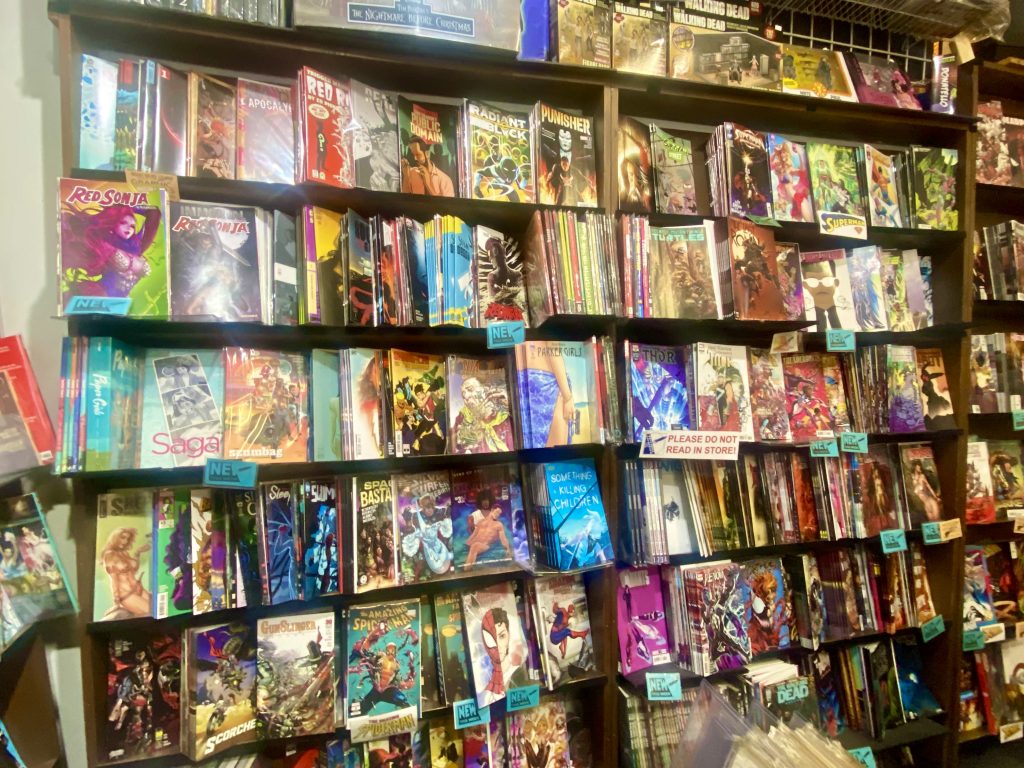By Frank Rizzo
Need an escape from the realities of the world, a nostalgic visit to reconnect with childhood friends, or a quick rescue from a superhero or two? Then perhaps you need to step into another universe. Alternate Universe is a little Chapel Street store in downtown New Haven that for decades has been a refuge from the realities of politics, pandemic and personal strife.
It’s a modest shop, not much larger than the size of a studio apartment, with every inch of space used, including vertically to the ceiling, filled with shelves, displays and bins of comic books. (The term “comic book,” is perfectly acceptable, says co-owner Joe Stinson, even for the more adult magazines which may be filled with fantasy, superheroes and darkness.)
It’s been a comic book shop under various names and owners for decades, going back to the ‘80s when it was Paperback Trader, a used-books-and-new-comics shop. That store evolved into the comic books-only Whirligig later in the decade, followed by Dream Factory, Moondog’s and, in 1996, Alternate Universe. In 2005, Stinson and co-owner Erik Yacko opened a second Alternate Universe in Milford.
What is the staying power for this particular location? Is there a secret portal in the back to another dimension? For a comic book fan, it’s abundance. Walk through the door of the store and your eyes won’t know where to look first as it takes in the floor-to-ceiling inventory of comic books, old and new, as well as graphic novels, toys, games, posters, action figures, collectables and more than a century’s worth of pop culture ephemera.
Looking for way-back nostalgia? There are old friends like Dick Tracy, Tarzan, Popeye, Crazy Kat and Little Orphan Annie. Move forward in time and then there’s Archie, Beetle Bailey, Casper, Baby Huey and Little Lulu. The 20th century classics include “Pogo,” “The Far Side,” “Doonesbury” and “The Simpsons.” There’s even vintage Classics Illustrated magazines based on “Ivanhoe” and “Kidnapped,” for those who remember fudging that book report.
But a deeper gaze around the store shows that a big attraction for contemporary readers are the superheroes and their many spin-offs, propelled in popularity by the last few decades worth of blockbuster movies, their sequels and a wave of streaming series into the world of fantasy, the macabre and science-fiction, said Stinson.
“DC is putting out something like 25 Batman titles right now,” he continued. “It’s crazy.”
But the field is widely and wildly diverse, Stinson explained, from the psychological complexity of “Watchmen” and “300” to the relative whimsical and colorful simplicity of Japanese anime and manga titles that attract adults as well as kiddies.
Although comics have some origins in the 18th century in Eastern Asia, they didn’t become popularized in the United States until the 1930s. Comic books cross all ages, genders, sexualities, ethnicities and races. “All Negro Comics” came out in the late ‘40s but the first black superhero in mainstream American comic books is The Black Panther, an African who first appeared in Fantastic Four issue in 1966. (The Western gunslinger Lobo also had a brief run in the ‘60s.)
Other LGBTQ comics and graphic novels are now not uncommon. Northstar in Alpha Flight was a superhero who was openly gay starting in the ‘90s. Most recently, Superman’s son Jonathan Kent just came out as gay. And strong female characters are making their space in magazines and magazines of their own, too; Wonder Woman is no longer playing second stringer in the superhero universe.
What’s hot these days are often reflected by what’s popular in film and television, whether it be “The Walking Dead,” “Game of Thrones” or the latest “Spider-Man” version.
Wednesday is a major event when new monthly comics arrive. “Sometimes there’s a line at the door,” stated Stinson, when the shop opens at 11 a.m. “Usually there’s about 50 new titles every week on average.”
And what’s Christmas for customers is Free Comic Book Day, held every year on the first Saturday in May. That is when the major comics publishers issue special free editions.
The value of comic books comes from people’s pleasure from the stories and drawings. However, a mint condition of the first issue of Action comic books where Superman first appeared sold at auction for over $3 million.
As for any owner who thinks their old comic books in the back of their closet may be their future annuity, only a handful make the auction level and the value greatly depends on condition, rarity and authenticity, which is independently determined.
Stinson, who grew up in Stratford and is a college English grad who majored in creative writing, said as a boy he got hooked on the stories and comic books like Teen Titans and X-Men, which helped him become a reader. Among his childhood favorites were Superman, Batman and Wonder Woman.
While some comic book titles come and go, many stay on for years, even decades, Stinson said. In the case of classic characters like Superman and Batman, it is closing in on a century.
“Comic books are kind of like soap operas,” he explained. “As long as the stories are good, people stay engaged.”







More Stories
Winter Wellness: Simple Ways to Feel Your Best All Season
A Hallmark Movie Featuring Slightly Old Folks
Hartford and Raleigh: A Tale of Two Hockey Hubs